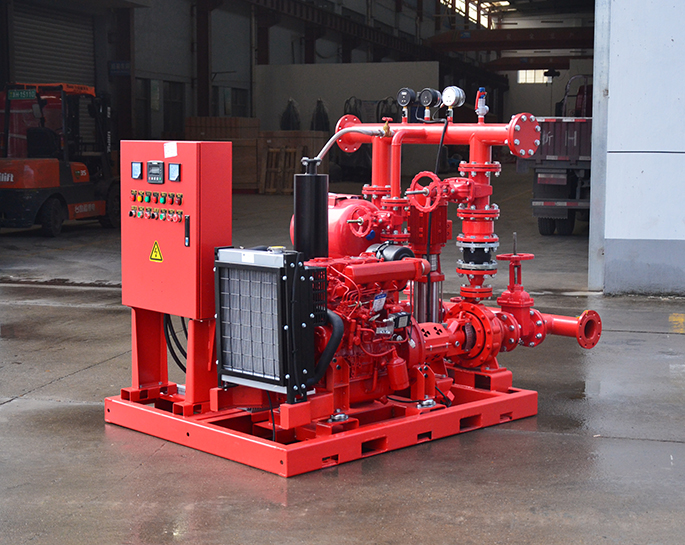What are the design considerations for fire pump suction piping?
May 09, 2024
Share:
Designing fire pump suction piping requires careful consideration to ensure the system operates efficiently and reliably during emergencies. Here are some key design considerations:
1. **Suction Piping Size**: Proper sizing of the suction piping is crucial to ensure an adequate flow of water to the fire pump. The pipe diameter should be sufficient to deliver the required flow rate without excessive friction loss.
2. **Straight Length Requirements**: A straight length of piping should be provided upstream of the fire pump suction inlet to minimize turbulence and ensure smooth flow. The length of straight pipe required varies depending on factors such as pipe diameter and flow velocity.
3. **Piping Layout**: The layout of the suction piping should be designed to minimize bends, elbows, and restrictions that could impede flow or create air pockets. Smooth, gradual bends should be used where necessary to maintain flow velocity and reduce pressure drop.
4. **Pipe Material and Construction**: The suction piping should be constructed from materials compatible with the water supply and suitable for firefighting applications. Common materials include ductile iron, steel, or corrosion-resistant alloys. Plastic piping may be used in certain applications but must be approved for fire service.
5. **Valves and Fittings**: Valves, strainers, and other fittings should be installed in the suction piping as needed for isolation, control, and maintenance. Valves should be of the appropriate type and size to handle the flow rates and pressures involved.
6. **Air Venting**: Adequate air venting is essential to prevent air from accumulating in the suction piping, which could cause cavitation or air locking of the pump. Air vents or automatic air release valves should be installed at high points in the piping system.
7. **Suction Lift Considerations**: If the fire pump will be required to lift water from a lower elevation or suction lift is involved, additional considerations such as priming methods, elevation changes, and the use of foot valves may be necessary to maintain prime and prevent pump cavitation.
8. **Pipe Supports and Anchors**: Proper support and anchoring of the suction piping are essential to prevent excessive vibration, stress, or movement that could lead to leaks or failure. Pipe supports should be installed at regular intervals and designed to withstand the weight of the piping and the forces exerted during operation.
9. **Accessibility and Maintenance**: Provisions should be made for easy access to the suction piping for inspection, maintenance, and repair. Piping should be installed in locations that allow for convenient access and clearance around valves and fittings.
By addressing these design considerations during the planning and installation of fire pump suction piping, engineers can ensure the system operates effectively and reliably to deliver water to the fire pump under all conditions.

1. **Suction Piping Size**: Proper sizing of the suction piping is crucial to ensure an adequate flow of water to the fire pump. The pipe diameter should be sufficient to deliver the required flow rate without excessive friction loss.
2. **Straight Length Requirements**: A straight length of piping should be provided upstream of the fire pump suction inlet to minimize turbulence and ensure smooth flow. The length of straight pipe required varies depending on factors such as pipe diameter and flow velocity.
3. **Piping Layout**: The layout of the suction piping should be designed to minimize bends, elbows, and restrictions that could impede flow or create air pockets. Smooth, gradual bends should be used where necessary to maintain flow velocity and reduce pressure drop.
4. **Pipe Material and Construction**: The suction piping should be constructed from materials compatible with the water supply and suitable for firefighting applications. Common materials include ductile iron, steel, or corrosion-resistant alloys. Plastic piping may be used in certain applications but must be approved for fire service.
5. **Valves and Fittings**: Valves, strainers, and other fittings should be installed in the suction piping as needed for isolation, control, and maintenance. Valves should be of the appropriate type and size to handle the flow rates and pressures involved.
6. **Air Venting**: Adequate air venting is essential to prevent air from accumulating in the suction piping, which could cause cavitation or air locking of the pump. Air vents or automatic air release valves should be installed at high points in the piping system.
7. **Suction Lift Considerations**: If the fire pump will be required to lift water from a lower elevation or suction lift is involved, additional considerations such as priming methods, elevation changes, and the use of foot valves may be necessary to maintain prime and prevent pump cavitation.
8. **Pipe Supports and Anchors**: Proper support and anchoring of the suction piping are essential to prevent excessive vibration, stress, or movement that could lead to leaks or failure. Pipe supports should be installed at regular intervals and designed to withstand the weight of the piping and the forces exerted during operation.
9. **Accessibility and Maintenance**: Provisions should be made for easy access to the suction piping for inspection, maintenance, and repair. Piping should be installed in locations that allow for convenient access and clearance around valves and fittings.
By addressing these design considerations during the planning and installation of fire pump suction piping, engineers can ensure the system operates effectively and reliably to deliver water to the fire pump under all conditions.


.png)
.png)

.png)


